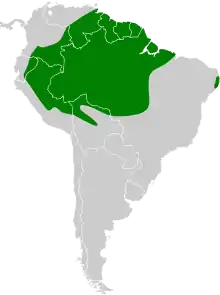Amazonian barred woodcreeper
The Amazonian barred woodcreeper (Dendrocolaptes certhia) is a species of bird in the Dendrocolaptinae subfamily, the woodcreepers. The northern barred woodcreeper (D. sanctithomae) was formerly included in this species. The Amazonian barred woodcreeper still includes the subspecies concolor, which sometimes is considered a separate species, the concolor woodcreeper.
| Amazonian barred woodcreeper | |
|---|---|
.jpg.webp) | |
| Sacha Lodge, Ecuador | |
| Scientific classification | |
| Kingdom: | Animalia |
| Phylum: | Chordata |
| Class: | Aves |
| Order: | Passeriformes |
| Family: | Furnariidae |
| Genus: | Dendrocolaptes |
| Species: | D. certhia |
| Binomial name | |
| Dendrocolaptes certhia (Boddaert, 1783) | |
 | |
It is found in the entire Amazon Basin of Brazil and the Guianas in the northeast, (Guyana, Suriname, and French Guiana). The countries surrounding the basin at the Andes are southern Colombia and Venezuela, also Ecuador, Peru, and Bolivia. A disjunct population exists 1800 km east of the Amazon Basin in eastern coastal Brazil in the states of Paraíba, Pernambuco, Alagoas, and Sergipe in a 600 km coastal strip. Its natural habitat is subtropical or tropical moist lowland forests.
Taxonomy
The Amazonian barred woodcreeper was described by the French polymath Georges-Louis Leclerc, Comte de Buffon in 1780 in his Histoire Naturelle des Oiseaux from two specimens collected in Cayenne, French Guiana.[2] The bird was also illustrated in a hand-coloured plate engraved by François-Nicolas Martinet in the Planches Enluminées D'Histoire Naturelle which was produced under the supervision of Edme-Louis Daubenton to accompany Buffon's text.[3] Neither the plate caption nor Buffon's description included a scientific name but in 1783 the Dutch naturalist Pieter Boddaert coined the binomial name Picus certhia in his catalogue of the Planches Enluminées.[4] The Amazonian barred woodcreeper is now one of five woodcreepers placed in the genus Dendrocolaptes that was introduced by the French naturalist Johann Hermann in 1804.[5][6] The generic name is from the Ancient Greek dendrokolaptēs meaning "woodpecker". The specific epithet certhia is from the Ancient Greek kerthios, a word used by Aristotle for an unidentified small insectivorous bird.[7]
Seven subspecies are recognised:[6]
- D. c. certhia (Boddaert, 1783) – east Colombia, Venezuela, the Guianas and north Brazil
- D. c. radiolatus Sclater, PL & Salvin, 1868 – southeast Colombia, east Ecuador, northeast Peru and northwest Brazil
- D. c. juruanus von Ihering, H, 1905 – east, southeast Peru, north, west, central Bolivia and west Brazil
- D. c. concolor Pelzeln, 1868 – northeast Bolivia and south central Brazil in the Madeira-Tapajós interfluvium
- D. c. medius Todd, 1920 – northeast Brazil south of the Amazon and east of the Tocantins River
- D. c. retentus Batista et al., 2013 – north central Brazil in the Xingu-Tocantins interfluvium
- D. c. ridgwayi Hellmayr, 1905 – northcentral Brazil in the Tapajós-Xingu interfluvium
References
- BirdLife International (2012). "Dendrocolaptes certhia". IUCN Red List of Threatened Species. 2012. Retrieved 26 November 2013.CS1 maint: ref=harv (link)
- Buffon, Georges-Louis Leclerc de (1780). "Le pic-grimpereaux". Histoire Naturelle des Oiseaux (in French). Volume 13. Paris: De L'Imprimerie Royale. pp. 122–124.
- Buffon, Georges-Louis Leclerc de; Martinet, François-Nicolas; Daubenton, Edme-Louis; Daubenton, Louis-Jean-Marie (1765–1783). "Le picucule, de Cayenne". Planches Enluminées D'Histoire Naturelle. Volume 7. Paris: De L'Imprimerie Royale. Plate xx.
- Boddaert, Pieter (1783). Table des planches enluminéez d'histoire naturelle de M. D'Aubenton : avec les denominations de M.M. de Buffon, Brisson, Edwards, Linnaeus et Latham, precedé d'une notice des principaux ouvrages zoologiques enluminés (in French). Utrecht. p. 38, Number 621.
- Hermann, Johann (1804). Observationes zoologicae quibus novae complures, aliaeque animalium species describuntur et illustrantur (in Latin). Argentorati: Amandum Koenig. p. 135.
- Gill, Frank; Donsker, David, eds. (2019). "Ovenbirds, woodcreepers". World Bird List Version 9.1. International Ornithologists' Union. Retrieved 13 August 2019.
- Jobling, James A. (2010). The Helm Dictionary of Scientific Bird Names. London: Christopher Helm. pp. 97, 133. ISBN 978-1-4081-2501-4.
External links
- "Barred woodcreeper"-Dendrocolaptes certhia photo gallery VIREO
- Photo-High Res-Dendrocolaptes certhia; Article-2; Article seplan.to.gov.br-"Flora and Fauna"
